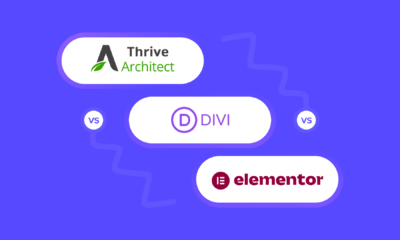TECHNOLOGY
Lenovo ushers in new era of edge automation at scale

Lenovo has unveiled the next generation of ThinkEdge remote automation and orchestration with the introduction of new software solutions to accelerate the deployment of edge solutions.
Lenovo’s new Lenovo Open Cloud Automation (LOC-A) 2.6 software delivers secure automated setup, enabling customers to complete global edge deployments for any number of locations in a matter of minutes, with one-touch provisioning from a single device, such as a PC, smart phone or tablet. New Lenovo XClarity edge-to-cloud management software also simplifies orchestration, maintenance and metering with one unified view into all Lenovo edge to cloud solutions. Lenovo also introduced its highly adaptable ThinkEdge SE10, an optimized entry level client edge device that allows customers to capture analog and digital data, such as temperature and humidity at the outermost edge of their business.
Together, the solutions will help businesses across a wide range of high-growth industries accelerate the global rollout of edge computing, generating faster insights and accelerating intelligent transformation.
As the amount of worldwide data from sensors, cameras and other sources exponentially grows, next generation technologies that deliver data centre-like computing to the edge are helping companies overcome networking constraints. Reducing the lag that occurs from massive data transfer, customers are leveraging edge computing technologies to process data at the source of its creation, benefitting from faster actionable insights and enabling innovative services for end users. However, edge site locations are often unmanned and hard to reach. Combined with new scalable server and computing services, Lenovo’s full range of far edge to cloud solutions will enable businesses to deploy an entire network of edge devices that are spread all across the world at once, ushering in a pivotal evolution in data intelligence.
Charles Ferland, VP and GM of edge computing, Lenovo Infrastructure Solutions Group, said: “As the need for edge computing grows, customers are facing challenges around deploying and managing numerous edge sites due to complexity and resource constraints.
“With the new Lenovo Open Cloud Automation and end-to-end ThinkEdge portfolio of clients and servers, Lenovo is enabling a new era of edge automation and management at scale. The ThinkEdge portfolio innovations enable customers to compute data wherever it is created and harness the power of AI at the edge.”
Unlocking intelligence at the edge
Modern edge infrastructure is unlocking data intelligence to help solve humanity’s greatest challenges in far-flung locales all over the world. The old-world city of Barcelona is being transformed into one of the smartest in the world, enabled by a network of Lenovo ThinkEdge servers that are powering its award-winning 5G infrastructure. Lifting a smartphone near Barcelona’s picturesque La Sagrada Familia church triggers a tourist video to play instantly on screen, while in the city’s glamorous Mercat de la Concepcio , a personal shopper broadcasts food recommendations directly via the high-tech augmented reality glasses. As the rollout continues, Lenovo ThinkEdge servers are deployed in street cabinets around the city, empowering artificial intelligence for improved emergency response, public safety and accessibility.
Built for the unique challenges of remote environments, the ruggedized ThinkEdge portfolio leverage Lenovo’s ThinkShield security capabilities, featuring the industry’s most modern and stringent security measures to keep data safe, such as bolstered physical and cyber tamper detection and locking bezels that prevent unauthorized access. The servers are also built to withstand Barcelona’s hot summer temperatures, as well as chilly winters.
In the future, these edge servers can help better manage traffic, sending messages from traffic lights to cars, warning when they are about to turn red, and helping them drive in a fuel-efficient fashion.
Enabling mass edge deployment
As the demand for edge computing grows, the new Lenovo Open Cloud Automation (LOC-A) 2.6 dramatically simplifies processes that used to require weeks of manual work to complete. LOC-A is capable of automating the deployment of ThinkEdge clients and servers at scale within minutes, eliminating the need for manual resources and potential human error. With LOC-A 2.6, Lenovo ThinkEdge servers can be shipped directly to their desired edge locations, where they can be securely authenticated, activated, and registered remotely, speeding time to value.
Juan Orlandini, chief architect and engineer at Insight, said: “When it comes to edge computing, there are different variables that need to be addressed. At Insight Enterprises Inc., oftentimes we are helping customers deploy systems in remote locations where space is limited, harder to access and conditions are harsher than in a traditional data centre. Each location individually is challenging, but the edge is a distributed environment that often numbers into the thousands if not tens of thousands. To help our clients scale edge solutions, we need enough compute power to support multiple diverse workloads and the tooling and logistics to manage everything efficiently. That’s why we’ve chosen Lenovo as an edge technology partner.”
LOC-A automatically and remotely updates the edge device’s firmware, then installs and configures all platform components like the operating system and cloud software. Previously, administrators had to inflexibly pre-load software at a factory, or undergo the logistically complex process of installing software images at staging areas, one at a time. With LOC-A 2.6, edge devices are installed through one-touch setup with minimal downtime, delivering immediate value through ease and efficiency of operation and enabling swift computing and insights from globally sourced data without lag time. LOC-A 2.6 is capable of onboarding Lenovo’s ThinkEdge portfolio of SE10, SE30, SE50, SE70, SE350, and SE450 servers.
Transforming business outcomes anywhere
The Lenovo ThinkEdge portfolio offers a full range of client and server edge infrastructure solutions, software and services. The new ThinkEdge SE10 client device with Intel Atom processor turns analogue measurements, such as temperature, lighting and humidity into digital data, which can then be analysed for insights and actions. The ThinkEdge SE10 compact and rugged design is optimised for analogue-to-data processing everywhere customers need it, including retail locations, manufacturing facilities and smart buildings. Leveraging the ThinkEdge, SE10, businesses can mitigate food waste, automate sorting and processing, improve inventory management and improve self-service or security functions throughout their operations. From extreme temperatures to the most constrained spaces, the SE10 is designed as the most versatile device in the ThinkEdge portfolio and available in an industrial-specific design, with even more rugged ThinkEdge SE10-i.
Lenovo’s fully integrated edge business also features a range of newly available support services, including Lenovo’s Edge Data Management Workshops and AI Innovators Program. Working with Lenovo, businesses can tap an extensive ecosystem of expert consultants who are trained to help customers identify a clear path for rollout and realize faster edge deployments to achieve scale.
Providing a complete portfolio of edge servers, AI-ready storage and solutions, Lenovo offerings are also available as-a-Service through Lenovo TruScale, which can extend workloads from the edge to the cloud in a consumption-based model.
Want to learn more about cybersecurity and the cloud from industry leaders? Check out Cyber Security & Cloud Expo taking place in Amsterdam, California, and London. Explore other upcoming enterprise technology events and webinars powered by TechForge here.
TECHNOLOGY
Next-gen chips, Amazon Q, and speedy S3

AWS re:Invent, which has been taking place from November 27 and runs to December 1, has had its usual plethora of announcements: a total of 21 at time of print.
Perhaps not surprisingly, given the huge potential impact of generative AI – ChatGPT officially turns one year old today – a lot of focus has been on the AI side for AWS’ announcements, including a major partnership inked with NVIDIA across infrastructure, software, and services.
Yet there has been plenty more announced at the Las Vegas jamboree besides. Here, CloudTech rounds up the best of the rest:
Next-generation chips
This was the other major AI-focused announcement at re:Invent: the launch of two new chips, AWS Graviton4 and AWS Trainium2, for training and running AI and machine learning (ML) models, among other customer workloads. Graviton4 shapes up against its predecessor with 30% better compute performance, 50% more cores and 75% more memory bandwidth, while Trainium2 delivers up to four times faster training than before and will be able to be deployed in EC2 UltraClusters of up to 100,000 chips.
The EC2 UltraClusters are designed to ‘deliver the highest performance, most energy efficient AI model training infrastructure in the cloud’, as AWS puts it. With it, customers will be able to train large language models in ‘a fraction of the time’, as well as double energy efficiency.
As ever, AWS offers customers who are already utilising these tools. Databricks, Epic and SAP are among the companies cited as using the new AWS-designed chips.
Zero-ETL integrations
AWS announced new Amazon Aurora PostgreSQL, Amazon DynamoDB, and Amazon Relational Database Services (Amazon RDS) for MySQL integrations with Amazon Redshift, AWS’ cloud data warehouse. The zero-ETL integrations – eliminating the need to build ETL (extract, transform, load) data pipelines – make it easier to connect and analyse transactional data across various relational and non-relational databases in Amazon Redshift.
A simple example of how zero-ETL functions can be seen is in a hypothetical company which stores transactional data – time of transaction, items bought, where the transaction occurred – in a relational database, but use another analytics tool to analyse data in a non-relational database. To connect it all up, companies would previously have to construct ETL data pipelines which are a time and money sink.
The latest integrations “build on AWS’s zero-ETL foundation… so customers can quickly and easily connect all of their data, no matter where it lives,” the company said.
Amazon S3 Express One Zone
AWS announced the general availability of Amazon S3 Express One Zone, a new storage class purpose-built for customers’ most frequently-accessed data. Data access speed is up to 10 times faster and request costs up to 50% lower than standard S3. Companies can also opt to collocate their Amazon S3 Express One Zone data in the same availability zone as their compute resources.
Companies and partners who are using Amazon S3 Express One Zone include ChaosSearch, Cloudera, and Pinterest.
Amazon Q
A new product, and an interesting pivot, again with generative AI at its core. Amazon Q was announced as a ‘new type of generative AI-powered assistant’ which can be tailored to a customer’s business. “Customers can get fast, relevant answers to pressing questions, generate content, and take actions – all informed by a customer’s information repositories, code, and enterprise systems,” AWS added. The service also can assist companies building on AWS, as well as companies using AWS applications for business intelligence, contact centres, and supply chain management.
Customers cited as early adopters include Accenture, BMW and Wunderkind.
Want to learn more about cybersecurity and the cloud from industry leaders? Check out Cyber Security & Cloud Expo taking place in Amsterdam, California, and London. Explore other upcoming enterprise technology events and webinars powered by TechForge here.
TECHNOLOGY
HCLTech and Cisco create collaborative hybrid workplaces

Digital comms specialist Cisco and global tech firm HCLTech have teamed up to launch Meeting-Rooms-as-a-Service (MRaaS).
Available on a subscription model, this solution modernises legacy meeting rooms and enables users to join meetings from any meeting solution provider using Webex devices.
The MRaaS solution helps enterprises simplify the design, implementation and maintenance of integrated meeting rooms, enabling seamless collaboration for their globally distributed hybrid workforces.
Rakshit Ghura, senior VP and Global head of digital workplace services, HCLTech, said: “MRaaS combines our consulting and managed services expertise with Cisco’s proficiency in Webex devices to change the way employees conceptualise, organise and interact in a collaborative environment for a modern hybrid work model.
“The common vision of our partnership is to elevate the collaboration experience at work and drive productivity through modern meeting rooms.”
Alexandra Zagury, VP of partner managed and as-a-Service Sales at Cisco, said: “Our partnership with HCLTech helps our clients transform their offices through cost-effective managed services that support the ongoing evolution of workspaces.
“As we reimagine the modern office, we are making it easier to support collaboration and productivity among workers, whether they are in the office or elsewhere.”
Cisco’s Webex collaboration devices harness the power of artificial intelligence to offer intuitive, seamless collaboration experiences, enabling meeting rooms with smart features such as meeting zones, intelligent people framing, optimised attendee audio and background noise removal, among others.
Want to learn more about cybersecurity and the cloud from industry leaders? Check out Cyber Security & Cloud Expo taking place in Amsterdam, California, and London. Explore other upcoming enterprise technology events and webinars powered by TechForge here.
TECHNOLOGY
Canonical releases low-touch private cloud MicroCloud

Canonical has announced the general availability of MicroCloud, a low-touch, open source cloud solution. MicroCloud is part of Canonical’s growing cloud infrastructure portfolio.
It is purpose-built for scalable clusters and edge deployments for all types of enterprises. It is designed with simplicity, security and automation in mind, minimising the time and effort to both deploy and maintain it. Conveniently, enterprise support for MicroCloud is offered as part of Canonical’s Ubuntu Pro subscription, with several support tiers available, and priced per node.
MicroClouds are optimised for repeatable and reliable remote deployments. A single command initiates the orchestration and clustering of various components with minimal involvement by the user, resulting in a fully functional cloud within minutes. This simplified deployment process significantly reduces the barrier to entry, putting a production-grade cloud at everyone’s fingertips.
Juan Manuel Ventura, head of architectures & technologies at Spindox, said: “Cloud computing is not only about technology, it’s the beating heart of any modern industrial transformation, driving agility and innovation. Our mission is to provide our customers with the most effective ways to innovate and bring value; having a complexity-free cloud infrastructure is one important piece of that puzzle. With MicroCloud, the focus shifts away from struggling with cloud operations to solving real business challenges” says
In addition to seamless deployment, MicroCloud prioritises security and ease of maintenance. All MicroCloud components are built with strict confinement for increased security, with over-the-air transactional updates that preserve data and roll back on errors automatically. Upgrades to newer versions are handled automatically and without downtime, with the mechanisms to hold or schedule them as needed.
With this approach, MicroCloud caters to both on-premise clouds but also edge deployments at remote locations, allowing organisations to use the same infrastructure primitives and services wherever they are needed. It is suitable for business-in-branch office locations or industrial use inside a factory, as well as distributed locations where the focus is on replicability and unattended operations.
Cedric Gegout, VP of product at Canonical, said: “As data becomes more distributed, the infrastructure has to follow. Cloud computing is now distributed, spanning across data centres, far and near edge computing appliances. MicroCloud is our answer to that.
“By packaging known infrastructure primitives in a portable and unattended way, we are delivering a simpler, more prescriptive cloud experience that makes zero-ops a reality for many Industries.“
MicroCloud’s lightweight architecture makes it usable on both commodity and high-end hardware, with several ways to further reduce its footprint depending on your workload needs. In addition to the standard Ubuntu Server or Desktop, MicroClouds can be run on Ubuntu Core – a lightweight OS optimised for the edge. With Ubuntu Core, MicroClouds are a perfect solution for far-edge locations with limited computing capabilities. Users can choose to run their workloads using Kubernetes or via system containers. System containers based on LXD behave similarly to traditional VMs but consume fewer resources while providing bare-metal performance.
Coupled with Canonical’s Ubuntu Pro + Support subscription, MicroCloud users can benefit from an enterprise-grade open source cloud solution that is fully supported and with better economics. An Ubuntu Pro subscription offers security maintenance for the broadest collection of open-source software available from a single vendor today. It covers over 30k packages with a consistent security maintenance commitment, and additional features such as kernel livepatch, systems management at scale, certified compliance and hardening profiles enabling easy adoption for enterprises. With per-node pricing and no hidden fees, customers can rest assured that their environment is secure and supported without the expensive price tag typically associated with cloud solutions.
Want to learn more about cybersecurity and the cloud from industry leaders? Check out Cyber Security & Cloud Expo taking place in Amsterdam, California, and London. Explore other upcoming enterprise technology events and webinars powered by TechForge here.
-

 WORDPRESS7 days ago
WORDPRESS7 days ago10 WordPress Influencers to Follow in 2024 – WordPress.com News
-

 SEARCHENGINES6 days ago
SEARCHENGINES6 days agoMore Google March 2024 Core Update Ranking Volatility
-

 PPC6 days ago
PPC6 days agoCompetitor Monitoring: 7 ways to keep watch on the competition
-

 PPC5 days ago
PPC5 days agoA History of Google AdWords and Google Ads: Revolutionizing Digital Advertising & Marketing Since 2000
-

 PPC6 days ago
PPC6 days ago31 Ready-to-Go Mother’s Day Messages for Social Media, Email, & More
-

 WORDPRESS6 days ago
WORDPRESS6 days agoThrive Architect vs Divi vs Elementor
-

 WORDPRESS5 days ago
WORDPRESS5 days agoTurkish startup ikas attracts $20M for its e-commerce platform designed for small businesses
-

 MARKETING6 days ago
MARKETING6 days agoHow To Adapt Your SEO and Content Strategies for SGE and AI Experiences














